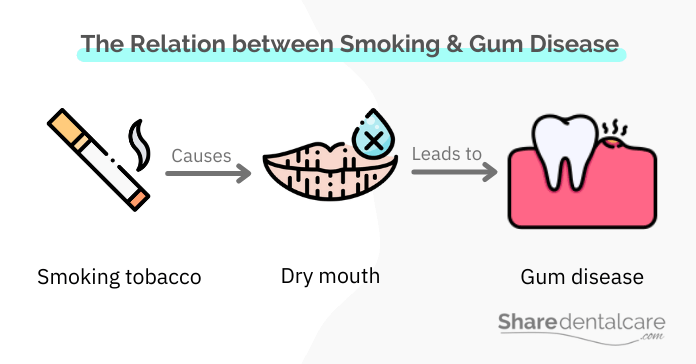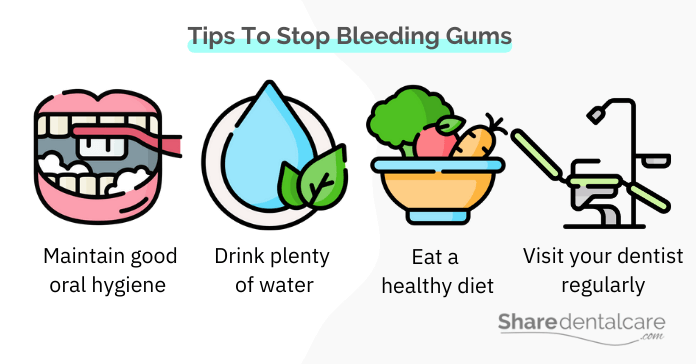Smokers have a higher risk for gum disease, oral cancer, and other serious health problems than people who don’t smoke. Gum disease is one of the most common oral problems smokers experience, which can cause bleeding gums, gum recession, and tooth loss. Smoking also causes bad breath, stained teeth, dark gums, and a decreased sense of taste and smell. Quitting smoking can improve your oral health and make it easier to keep your teeth healthy. In this blog post, we look at what causes bleeding gums after quitting smoking.
Why Do I Have Bleeding Gums?
Bleeding gums is a sign of gum disease, a bacterial infection of the gums. Poor oral hygiene causes the accumulation of plaque on teeth, which is a sticky film of bacteria. Bacteria in plaque release toxins that irritate the gums, causing bleeding and swelling. If plaque isn’t removed by brushing and flossing every day, it will harden into tartar, which can only be removed by a professional cleaning. Poor oral hygiene and smoking are the most common causes of gum disease.
Many smokers don’t know they have gum disease from tobacco until it is too late because smoking hides the signs of gum disease such as red, swollen, and bleeding gums. If you are a smoker, some other signs and symptoms may indicate you have gum disease, including:
- Persistent bad breath or a bad taste in your mouth.
- Painful chewing.
- Gum abscess.
- Gum recession, the teeth appear longer than usual.
- Infected gum pockets.
- Loose teeth and even tooth loss.
After quitting smoking, you may start to notice red, swollen, and bleeding gums. We will discuss why this happens in more detail below.

The Relation between Smoking & Gum Disease
Smokers have twice the risk for gum disease in comparison with nonsmokers because:
- Smoking dries out your mouth, making it harder to fight off bacteria. Saliva plays an important role in cleansing the mouth and killing bacteria.
- Smoking reduces the blood flow to your gums, which hampers your ability to fight off gum disease.
- The chemicals in cigarette smoke irritate the gums.
- Smoking weakens your body’s immune system, making it harder for your body to fight infection.
If you are a smoker, you may not notice gums bleeding but it may appear after quitting smoking. So, if you notice any of the other signs and symptoms of gum disease, consult a dentist as soon as possible to get it treated and prevent complications.
Read more about how can you get gingivitis.

Why My Gums Start Bleeding After Quitting Smoking?
When you smoke, the nicotine in cigarettes constricts the blood vessels in your mouth, which decreases the amount of blood and oxygen that reaches your gums. It can cause the gums to become inflamed and eventually to recede from the teeth. The lack of blood and oxygen can also damage the gums and make them more susceptible to infection.
It means that smoking causes poor blood circulation in the gums, which worsens the condition of gums and hides the signs of gum infection like red, swollen, or bleeding gums.
After you quit smoking, the blood circulation in your gums will improve, and the gums will get more blood and oxygen. Bleeding gums after quitting smoking can be a sign of an infection or other problem because smoking was hiding it before.
Can Gums Bleeding Stop After Quitting Smoking?
Quitting smoking can improve the health of your gums but bleeding gums may not go away until you treat the underlying cause. So, it’s important to see your dentist as soon as possible for an oral exam to determine the cause of bleeding gums and treat it. Bleeding gums after quitting smoking can be a sign of many problems, such as:
- Gum disease (gingivitis infection or periodontitis).
- Brushing your teeth too hard.
- Started a flossing routine or flossing your teeth incorrectly.
- Pregnancy gingivitis.
- Vitamin deficiency (Vitamin C and K)
- Taking certain medications, such as blood thinners
- Can be a warning sign for diabetes.
- Medical conditions, such as bleeding disorder and leukemia.
How to Stop Bleeding Gums After Quitting Smoking?
To stop bleeding gums after quitting smoking, you need to treat the underlying cause. So, it’s important to see your dentist as soon as possible for an oral exam to determine the cause of bleeding gums and treat it. Gum bleeding usually occurs as a sign of gum disease, so your dentist may perform professional teeth cleaning to remove plaque and tartar buildup. Also, you need to improve your oral hygiene habits.
Sometimes, your dentist might suggest scaling and root planing. Scaling is a procedure in which your dentist will use instruments to remove plaque and tartar from below the gum line. Root planing is a procedure in which your dentist will smooth your tooth surfaces to prevent plaque buildup.
In severe cases, your dentist might suggest surgery to allow your gums to fit snugly around the teeth again. Also, your dentist may prescribe antibiotics to help control the infection.
Read more about do gums heal after quitting smoking.
Home Care Tips
In addition to visiting your dentist, there are some things you can do at home to help improve gum health and stop bleeding gums after quitting smoking. You can try the following tips:
- Brush your teeth with a fluoride toothpaste at least twice daily.
- Use a soft-bristled toothbrush and brush gently in a circular motion. Don’t scrub too hard or use harsh toothpaste because it can irritate your gums.
- Floss daily to remove plaque and food particles from between your teeth.
- Use antimicrobial mouthwash to prevent plaque buildup.
- Eat a healthy diet that includes fruits and vegetables.
- Drink plenty of water to keep your mouth moist.
- See your dentist at least once every six months for a check-up and professional teeth cleaning.

Bleeding Gums After Quitting Smoking – Conclusion
When you smoke, the nicotine in cigarettes constricts the blood vessels in your mouth, which decreases blood flow in your gums. Poor blood circulation worsens the condition of gums and makes the gums more susceptible to infection. If your gums become infected, signs like gum redness, swelling, or bleeding may go unnoticed due to the poor blood circulation in the gums. After you quit smoking, the blood flow in your gums will improve, causing bleeding gums.
Bleeding gums after quitting smoking can be a sign of an infection or other problem. So, it’s important to see your dentist as soon as possible for an oral exam to determine the underlying cause and treat it.